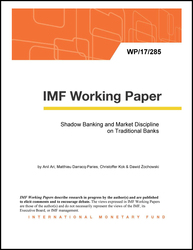
Shadow Banking and Market Discipline on Traditional Banks
We present a model in which shadow banking arises endogenously and undermines market
discipline on traditional banks. Depositors' ability to re-optimize in response to crises
imposes market discipline on traditional banks: these banks optimally commit to a safe
portfolio strategy to prevent early withdrawals. With costly commitment, shadow banking
emerges as an alternative banking strategy that combines high risk-taking with early
liquidation in times of crisis. We bring the model to bear on the 2008 financial crisis in the
United States, during which shadow banks experienced a sudden dry-up of funding and
liquidated their assets. We derive an equilibrium in which the shadow banking sector
expands to a size where its liquidation causes a fire-sale and exposes traditional banks to
liquidity risk. Higher deposit rates in compensation for liquidity risk also weaken threats of
early withdrawal and traditional banks pursue risky portfolios that may leave them in default.
Policy interventions aimed at making traditional banks safer such as liquidity support, bank
regulation and deposit insurance fuel further expansion of shadow banking but have a net
positive impact on financial stability. Financial stability can also be achieved with a tax on
shadow bank profits.
Publication date: December 2017
ISBN: 9781484335376
$18.00
Add to Cart by clicking price of the language and format you'd like to purchase
Available Languages and Formats
| English |
Prices in red indicate formats that are not yet available but are forthcoming.
Topics covered in this book
This title contains information about the following subjects.
Click on a subject if you would like to see other titles with the same subjects.
Market discipline , Fire-sales , Financial Markets and the Macroeconomy , Government Policy and Regulation
Summary
Copyright © 2010 - 2024
Powered by:
AIDC



